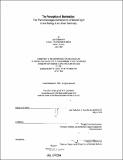| dc.contributor.advisor | Stanford Anderson. | en_US |
| dc.contributor.author | DeBartolo, Jack, III | en_US |
| dc.date.accessioned | 2011-09-13T17:38:33Z | |
| dc.date.available | 2011-09-13T17:38:33Z | |
| dc.date.copyright | 1994 | en_US |
| dc.date.issued | 1994 | en_US |
| dc.identifier.uri | http://hdl.handle.net/1721.1/65693 | |
| dc.description | Thesis (M.S.)--Massachusetts Institute of Technology, Dept. of Architecture, 1994. | en_US |
| dc.description | Includes bibliographical references (leaves 84-86). | en_US |
| dc.description.abstract | This thesis addresses the experiential dimension of architecture as it relates to the dynamics of light and the universal presence of the phenomenal. The effort is to (re)imagine the environment: to behold the pageantry and reverence for the potent qualities of natural light and the orderly passage of time as dictated by the movement of the planets, stars, earth, sun and moon. The program for the design intervention addresses the fundamental need for enrichment, reflection and pause in the urban realm. To achieve this, the inhabitant must be shaken free from his comfortable and limiting perception of the world and be placed in an environment where he is free to sense the magic in a sky he normally takes for granted. This 'inhabitable light' becomes profound when it permits one to register his or her own position within the larger context of the moving universe. Architecture must be a lens for a greater perception of the environment without relying on artifice and imagery. The approach of this thesis is to sense the nature of natural light and search for new ways to impact the perception of the phenomenal through architecture, not to search for simple solutions. The humane use of natural light has a vigorous impact in the making of spaces which evoke the spirit. The associational basis for making decisions will be explored through discussion of perception, analysis of precedent and distilling of theory, within some rather distinct categories of light experience. The design application does not begin when the theory finishes, but rather works simultaneously with it, encouraging a dialogue between theory and form. The underlying motivation is to commence a (re)orientation and (re)birth of the natural environment as the critical component of the phenomenal experiential dimension of architecture. If we are to embody a sense of the eternal in our architecture, we must strive to understand the immeasurable. | en_US |
| dc.description.statementofresponsibility | by Jack DeBartolo, III. | en_US |
| dc.format.extent | 86 leaves | en_US |
| dc.language.iso | eng | en_US |
| dc.publisher | Massachusetts Institute of Technology | en_US |
| dc.rights | M.I.T. theses are protected by
copyright. They may be viewed from this source for any purpose, but
reproduction or distribution in any format is prohibited without written
permission. See provided URL for inquiries about permission. | en_US |
| dc.rights.uri | http://dspace.mit.edu/handle/1721.1/7582 | en_US |
| dc.subject | Architecture | en_US |
| dc.title | The perception of illumination : the phenomenological dimensions of natural light in the making of an urban sanctuary | en_US |
| dc.title.alternative | Phenomenological dimensions of natural light in the making of an urban sanctuary | en_US |
| dc.type | Thesis | en_US |
| dc.description.degree | M.S. | en_US |
| dc.contributor.department | Massachusetts Institute of Technology. Department of Architecture | |
| dc.identifier.oclc | 31258664 | en_US |
